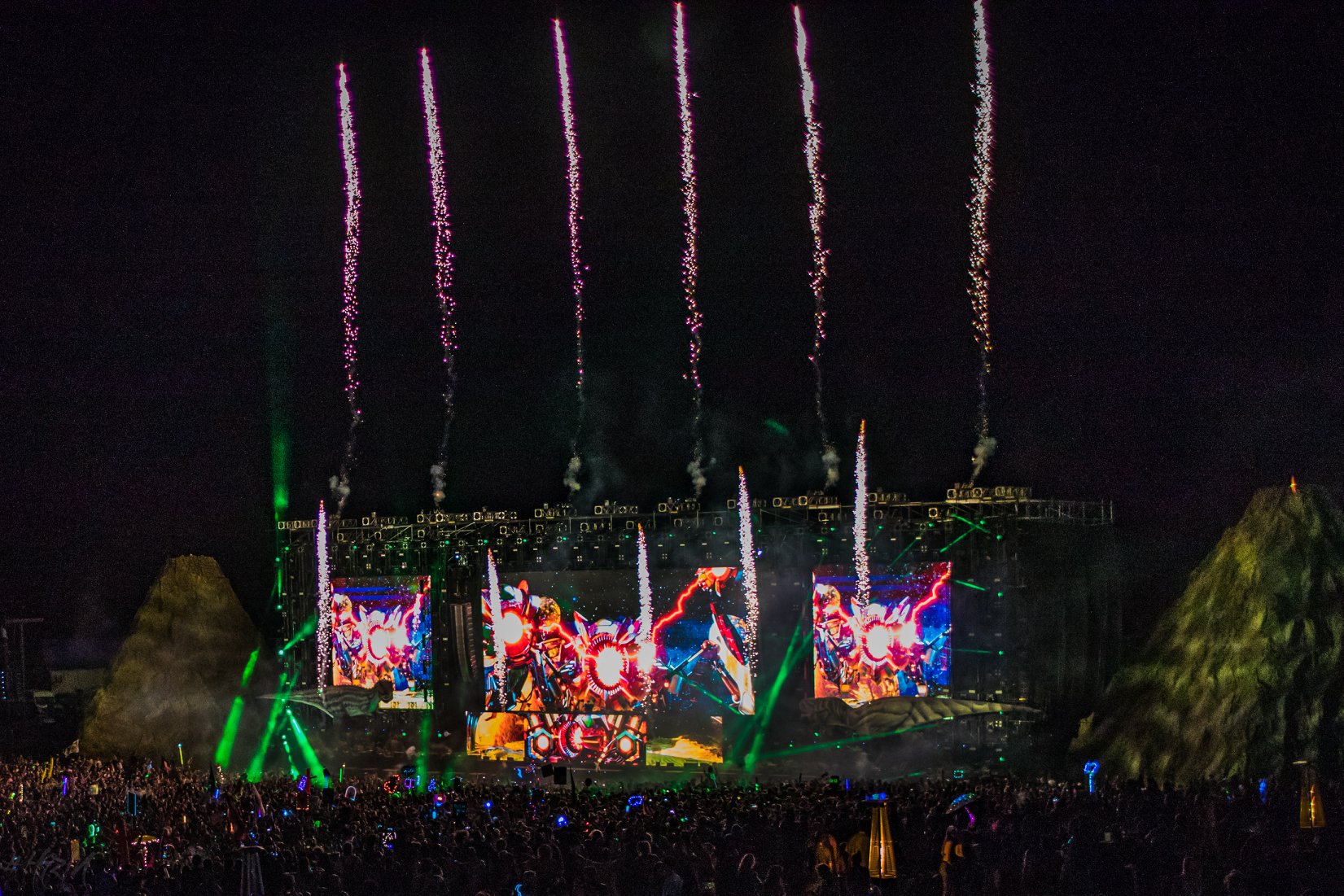When thinking of rave fashion, so many trends come to mind–here are timeless staples like Kandi and cyclical trends like tutus and platform boots–but one garment, in particular, has taken the scene by storm: The pashmina. From major festivals to underground shows, people of all genders love wearing eye-popping scarves on the dancefloor today–and many of us probably know at least one person who spends hours and hours hunting for the perfect pashmina online and in thrift stores. If you want to paint a picture of what rave fashion in North America looks like, pashminas are a must. Yet despite their vast popularity here, the pashmina’s origin story started far away from the booming bass and blazing lasers of music festivals.
I remember feeling amused and confused when I first saw pashminas on the dancefloor– it was 2018. I’d just started raving again following a four-year hiatus, and seemingly, they were everywhere. Before that, the only place I’d ever seen so many pashminas in one place was thousands of miles away while studying abroad in the Middle East. As far as I knew, Pashminas were endemic to Arab, Persian, and Indian cultures. In 2014, I felt special bringing home this velvety garment after my semester abroad ended– no one else around me would have anything like it, I assumed. I was wrong. How did the iconic scarf become a rave staple? And what drives ravers’ incredible demand for this product today?
To uncover the story of the rave community’s most beloved garment, we must take a trip back in time and a quick trek across the globe:
Traditional pashmina scarves originate from the Himalayas and certain regions of Northern India. Authentic pashmina scarves are woven from the wool of a special breed of goat unique to the area and often considered a luxury textile. Traditional pashminas were sold and traded across the West as far back as the 18th century, and they are still popular garments in the Middle East and many other parts of the world today. More economical versions of the scarves made with cheaper materials also became famous as travel and tourism increased in modern days, especially among Westerners traveling in the Middle East, Persia, and South Asia.
Pashmina scarves became a style icon among travelers, and Western festival enthusiasts also picked up on the trend. Some suggest that the pashmina first entered the rave scene thanks to the Goa Trance movement. Goa Trance is a genre of psychedelic trance music (psytrance) that originated in Goa, India, in the early 1990s. The genre was known for attracting Western ravers interested in spiritual and otherwise alternative lifestyles. When these travelers brought Pashminas back from their travels, other festival goers and ravers in the US noticed and eventually started wearing the garment themselves.
Many people point to Burning Man, in particular, as a potential ground zero for the pashmina’s rise in the US festival scene. This theory makes sense since it neatly ties the pashmina’s Indian origins to the US via the spiritually driven “seekers” Burning Man is well known for.
From there, pashminas became more popular as social media entered the picture, especially around the mid-2010s. The trend picked up momentum in the bass music and dubstep scenes, and many famous dubstep artists and labels filled entire merchandise lines with Pashmina designs (Wooli, Excision, and BTSM come to mind).
By 2020, the pashmina became a rave fashion staple–but fashion wasn’t the only key to its popularity. The versatile garment serves many benefits in a festival setting. Pashminas are lightweight (depending on the material) but also warm, soft, and easily styled or stored. They can be worn loose around the head for protection from the sun, wind, and dust or wrapped more tightly to keep warm in chilly air. They can make a comfy cushion when you need a quick place to sit, or they can even make an impromptu pillow or blanket.
Many people also use pashminas as sensory aids in the chaos of a festival environment. As someone with sensory sensitivities, my pashmina can be a calming tool when I need a quick barrier from my surroundings. It’s good to be aware of this when someone is wearing a pashmina over their head in the crowd. The person might be feeling overwhelmed or may want to take a minute to themselves–either way; it’s best to watch their body language and to be gentle if approaching them.
With its many uses, it’s no surprise that demand for pashminas in the rave scene grew so great. With that said, ravers hunting for their next great find should have a bit of consumer awareness around the Pashmina label. For lack of better words, don’t get ripped off– most “pashminas” marketed to ravers are not made with authentic pashmina, which is the name of the material woven from goat wool. Authentic pashmina scarves sell at a relatively high price point, and some less-than-transparent vendors may use this misnomer to their advantage to make an extra profit.
One way to tell the difference is that natural pashmina wool is thicker and softer in texture than commercially sold fashion scarves and has a mild water-repellent quality. Unfortunately, it’s often hard to determine the quality of a pashmina product when ordering from a commercial vendor, especially if shopping online. Researching and knowing what’s considered a reasonable price point before purchasing is probably your best bet.
The pasmina’s evolution from a rare textile of the remote Indian mountains to one of the most popular staples of rave fashion is truly unique. It’s an exciting insight into how many different cultures and traditions influence music festival culture and rave fashion. Fashion also serves as a goal-post for measuring the passage of time and trends, and the Pashmina has become a defining trait of the modern North American rave scene. Will something else eventually take its place? Hard to say–but for now, ravers’ love for the beloved garment burns strong as ever.
Images by Hazin Lane Photography and Lost Lands Music Festival











